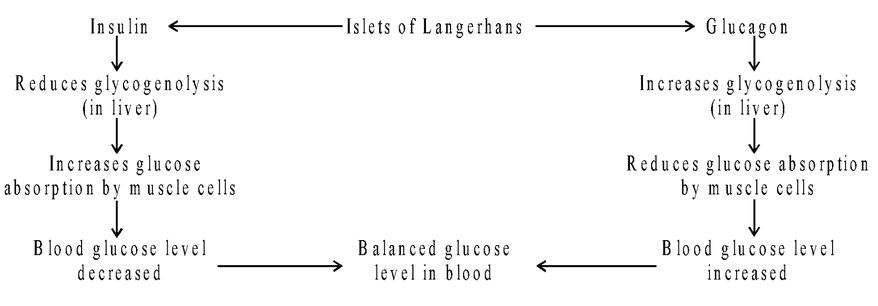Pancreas
Endocrine System of Class 11
glucose lasting for hours & even days.
Glucagon is a powerful lipolytic agent. It acts on adipose tissue and causes release of FFA (Free Fatty Acids) and Glycerol in circulation. In liver excess of FFA are converted to ‘Ketone bodies’ ie acetoacetic
acid, acetone and -hydroxybutyric acid (ketogenic action).
Glucagon is glycogenolytic, gluconeogenic, lipolytic and ketogenic. It thus favours breakdown of stored nutrients and is a hormone of energy release. An increase in blood glucose level decreases plasma
concentration of glucagon. Its secretion is stimulated by hypoglycemia and by epinephrine. Its secretion is inhibited by insulin and somatostatin.
nsulin
Insulin hormone is secreted by beta cells of Islets of Langerhans.
Schaefer (1912) gave the name Insulin.
Insulin was discovered by Banting and Best in 1921. They extracted insulin from pancreas of a new born calf and showed that when insulin is injected in dogs it reduced their blood glucose level.
Crystalline insulin was prepared by Abel in 1926.
Frederick Sanger (1952) worked out the full chemical structure of Insulin. For discovering the amino acid sequence in insulin, F. Sanger was awarded Nobel prize in 1958. Sanger obtained a second Nobel prize
in 1980 for his work on chemicals structure of gene [Sanger is the first British scientist to win nobel prize twice.
Chemically insulin is a proteinaceous hormone (large polypeptide). It contains 51 amino acids arranged in two chains, an acidic A-chain containing 21 amino acid residues and a basic B-chain containing 30
amino acid residues. A and B chains are connected by two disulphide (S-S) bridges and a third disulphide bridge is located on the A chain. Breaking the disulphide bonds inactivates insulin
Molecular weight of insulin is 6000. Human insulin was synthesized by Tsan in 1965. Insulin is the first protein to be synthesized by scientists in laboratory.
The 51 amino acids arrangement varies from species to species without altering its biological activity, but if insulin of one animal is injected for
prolonged period into another species it may lead to antigenic properties by producing antibodies. As antibody titre is not high, it therefore
causes no problem. If increases, it inhibits endogenously secreted insulin (Insulin Resistance) but is usually responsive to insulin from other
species. Insulin from cattle or sheep is able to evoke the formation of antibodies in man which cause allergic reactions where as pig insulin
which more closely resembles human insulin is much better tolerated. Beef insulin is so similar to human insulin that it can be used to treat human diabetes.
Insulin is synthesized on ribosomes in rough endoplasmic reticulum of  cells of pancreatic Islets as proinsulin which gets translocated to Golgi
cells of pancreatic Islets as proinsulin which gets translocated to Golgi
apparatus to form insulin. The fact that normal pancreatic tissue is rich in zinc (Zn) indicates that insulin contains Zinc. [Hodkins said that
insulin unit is composed of 6 insulin molecules and 2 Zn atoms]. Insulin synthesis is impaired in deficiency of vitamin C .
Insulin binds with plasma protein called synalbumin.
Half life of insulin in circulation is 5-10 mins.
After performing its function insulin gets metabolized. In the body 80 % gets metabolised by liver and kidneys by Hepatic glutathione insulin
transhydrogenase enzyme (HGIT), which breaks disulphide bridge (S-S) to SH groups with separation of A and B chains. Once the
disulphide bridge is removed, biological activity of insulin is lost. 20 % of insulin gets metabolised by rest of body tissues and is destroyed by
enzyme insulinase (insulin protease).
Alloxan, streptozotocin, cobalt chloride are the compounds widely used by scientists to study cell physiology of Islets of Langerhans. Alloxan & streptozotocin destroys B cells of Islets and produces diabetic
state. These drugs inhibit growth of tumors. Cobalt chloride destroys Alpha cells of Islets. Diazoxide and Phenytoini also destroys Allpha cells of islets.
Target Cells :
Insulin is required for entry of glucose into most cells, in particular into muscle cells (including heart muscles), kidney, liver and adipose tissue.
Insulin receptor on the cell membrane is a glycoprotein. The insulin exerts its effect without entering the cell on which it acts. Brain cells
(Neurons ) and RBC (Erythrocytes) are unresponsive to insulin. Glucose enters these cells by passively moving down a steep concentration
gradient between blood plasma and the interior of the cell.
Somatostatin
Secreted from -cells, also called as GHIH and it balances the level of glucagon and insulin as per requirement of the body.

- Introduction of Endocrine System
- Hormones
- Types of Hormones
- Types of Endocrine Glands
- Hypothalamus
- Pituitary Gland (hypophysis)
- Pineal Glands (Epiphysis)
- Thyroid Gland
- Parathyroid gland
- Adrenal (or Suprarenal) Gland
- Pancreas
- Pancreatic Gland
- Gonads
- Thymus Gland
- Exercise 1
- Exercise 2
- Exercise 3
- Exercise 4
- Exercise 5









